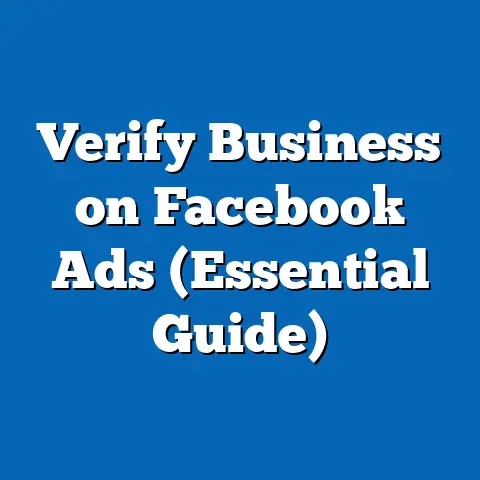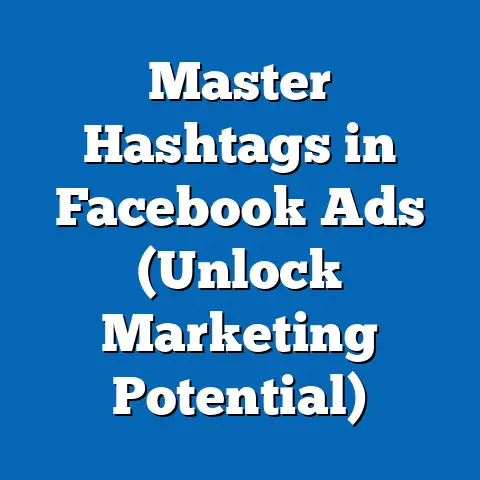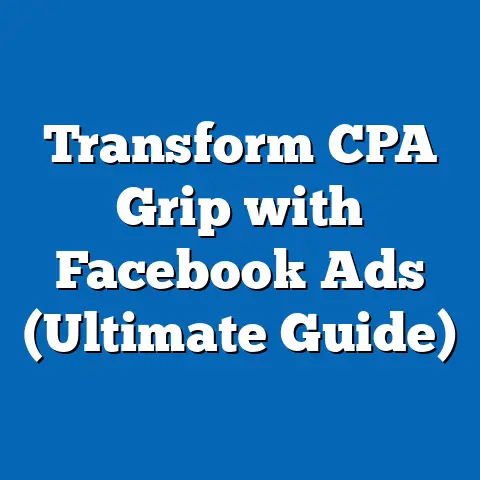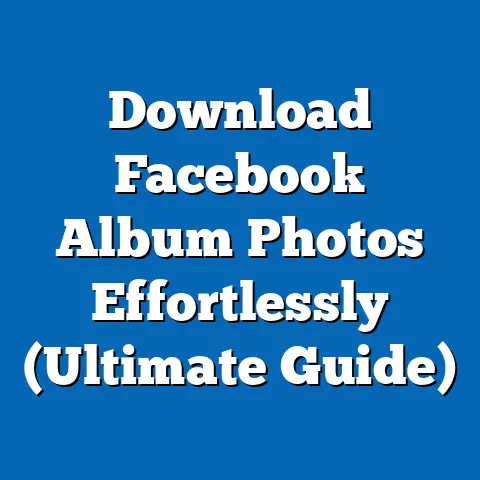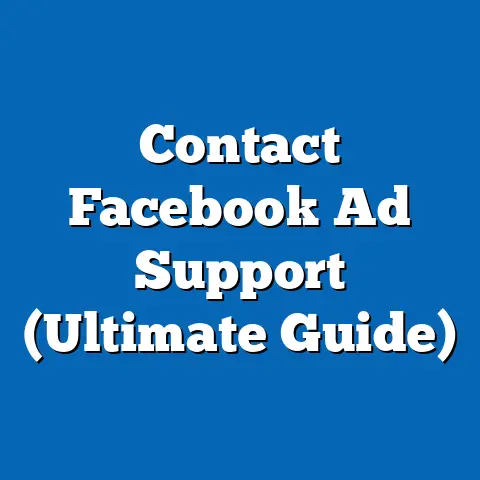Do Facebook Ads Work? (Unlock Proven Strategies)
There’s a common misconception floating around, particularly among small business owners: “Facebook Ads don’t work for my business.” I’ve heard it countless times, and frankly, it used to be a sentiment I somewhat understood. I remember when I first started my own venture, I threw a few bucks at a Facebook ad, saw little to no results, and assumed it was a waste of time and money. However, what I didn’t realize then was that my approach was completely wrong. I was essentially throwing spaghetti at the wall and hoping something would stick.
The truth is, this assertion often stems from a misunderstanding of how Facebook Ads operate and, more importantly, who can benefit from them. It’s easy to assume that only large corporations with massive marketing budgets can truly see a return on their investment. But I’m here to challenge that idea.
Consider this: Facebook boasts billions of active users worldwide. According to recent stats, Facebook’s ad revenue was over $130 billion in 2023, proving that businesses are investing heavily in the platform. Why would they do that if it didn’t work? The key is understanding how to make them work for you.
I want to show you why Facebook Ads are a powerful tool for businesses of all sizes, and more importantly, give you the proven strategies to unlock their potential. It’s not about luck; it’s about knowledge and execution.
The Power of Facebook Ads
Let’s dive into why Facebook Ads are such a force to be reckoned with in the digital marketing landscape. It’s not just about popularity; it’s about the sheer scale and precision they offer.
Statistics and Reach
Facebook isn’t just a social media platform; it’s a global phenomenon. With billions of monthly active users, it offers unparalleled reach to businesses looking to connect with potential customers.
- Massive User Base: As of 2024, Facebook boasts over 3 billion monthly active users. This means that, statistically, a significant portion of your target audience is likely already on the platform.
- Demographic Diversity: What makes Facebook so powerful is not just the number of users, but the diversity of the user base. You can find people of all ages, backgrounds, interests, and income levels. This allows you to target specific demographics and tailor your ads to resonate with different segments of the population.
- Engagement Rates: Despite the rise of other social media platforms, Facebook continues to have high engagement rates. People actively like, comment, share, and click on content, making it a prime platform for advertising.
- Small Business Success Stories: Don’t just take my word for it. Many small businesses have experienced significant growth through Facebook Ads. I remember working with a local bakery that struggled to attract new customers. By implementing a targeted Facebook Ads campaign, they saw a 30% increase in sales within just a few months. They targeted people in their local area who were interested in baking, desserts, and local businesses. It was a game-changer for them.
Targeting Capabilities
This is where Facebook Ads truly shine. It’s not enough to just have a large audience; you need to be able to reach the right audience. Facebook’s advanced targeting options allow you to do just that.
- Demographic Targeting: You can target people based on age, gender, location, education, job title, and more. This allows you to narrow down your audience to the people who are most likely to be interested in your products or services.
- Interest-Based Targeting: This is where things get really interesting. Facebook allows you to target people based on their interests, hobbies, and the pages they like. For example, if you sell hiking gear, you can target people who are interested in hiking, camping, and outdoor activities.
- Behavioral Targeting: Facebook tracks user behavior on and off the platform, allowing you to target people based on their purchase history, online activity, and device usage. This can be incredibly powerful for reaching people who are actively looking for products or services like yours.
- Custom Audiences: This is one of my favorite features. You can upload your own customer lists (email addresses, phone numbers) and target those people directly on Facebook. This is a great way to reach existing customers with special offers or new product announcements.
- Lookalike Audiences: This is where you can leverage Facebook’s algorithm to find new customers who are similar to your existing customers. You can create a lookalike audience based on your customer list, website visitors, or page fans. This is a great way to expand your reach and find new potential customers.
Takeaway: Facebook Ads are not just about reaching a large audience; they’re about reaching the right audience with the right message. Understanding the power of targeting is crucial for success.
Understanding the Facebook Ads Ecosystem
Before you jump into creating your first ad, it’s important to understand the different components of the Facebook Ads ecosystem. This includes the various ad formats, campaign objectives, and the overall structure of the platform.
Ad Formats
Facebook offers a wide variety of ad formats to choose from, each with its own strengths and weaknesses. The best ad format for you will depend on your goals, your target audience, and your budget.
- Image Ads: These are simple ads that consist of an image and some text. They’re a great way to showcase your products or services and are relatively easy to create.
- Video Ads: Video ads are more engaging than image ads and can be a great way to tell your brand story or demonstrate your product in action.
- Carousel Ads: Carousel ads allow you to showcase multiple images or videos in a single ad unit. This is a great way to highlight different features of your product or tell a more complex story.
- Collection Ads: Collection ads are designed for e-commerce businesses and allow you to showcase a catalog of products in a visually appealing way.
- Instant Experience Ads: These are full-screen ads that load instantly when someone clicks on them. They can be used to create immersive experiences that showcase your brand and products.
Best Use Cases:
- Brand Awareness: Image and video ads are great for raising brand awareness and introducing your brand to a new audience.
- Lead Generation: Lead ads allow you to collect leads directly from Facebook without sending people to your website.
- Conversions: Carousel and collection ads are great for driving conversions and selling products or services.
Campaign Objectives
When you create a Facebook Ads campaign, you’ll be asked to choose a campaign objective. This objective tells Facebook what you want to achieve with your ad campaign.
- Awareness: The awareness objective is designed to reach as many people as possible and increase brand awareness.
- Consideration: The consideration objective is designed to drive traffic to your website, generate leads, or increase engagement on your Facebook page.
- Conversion: The conversion objective is designed to drive sales, generate leads, or encourage people to take a specific action on your website or app.
Aligning Objectives with Business Goals:
It’s crucial to choose the right campaign objective based on your business goals. If you’re trying to raise brand awareness, choose the awareness objective. If you’re trying to generate leads, choose the lead generation objective. If you’re trying to drive sales, choose the conversion objective.
Takeaway: Understanding the different ad formats and campaign objectives is essential for creating effective Facebook Ads campaigns. Choose the formats and objectives that align with your goals and target audience.
Proven Strategies for Success
Now that you understand the basics of the Facebook Ads ecosystem, let’s dive into some proven strategies for success. These strategies will help you create effective ads that resonate with your target audience and drive results.
Crafting Compelling Ad Copy
Your ad copy is what will ultimately convince people to click on your ad and take action. It’s important to write persuasive ad copy that resonates with your target audience and highlights the benefits of your product or service.
- Know Your Audience: Before you start writing, take the time to understand your target audience. What are their pain points? What are their desires? What language do they use?
- Highlight the Benefits: Don’t just list the features of your product or service. Focus on the benefits and how it will solve your audience’s problems or improve their lives.
- Use Strong Calls-to-Action (CTAs): Your ad copy should always include a clear call-to-action that tells people what you want them to do. Use action words like “Shop Now,” “Learn More,” “Sign Up,” or “Get Started.”
- Keep it Concise: People have short attention spans, so it’s important to keep your ad copy concise and to the point. Get your message across quickly and effectively.
- Use Emotion: Emotion is a powerful tool for persuasion. Tap into your audience’s emotions by using words and phrases that evoke feelings of excitement, happiness, or urgency.
Examples of Strong CTAs:
- “Shop Now and Get 20% Off!”
- “Learn More About Our New Product”
- “Sign Up for Our Free Webinar”
- “Get Started Today and Transform Your Business”
Designing Eye-Catching Visuals
Your ad visuals are just as important as your ad copy. They’re what will grab people’s attention and make them stop scrolling. It’s important to use high-quality visuals that are visually appealing and relevant to your target audience.
- Use High-Quality Images and Videos: Avoid using blurry or pixelated images. Use high-resolution images and videos that are visually appealing and professional-looking.
- Use Branding: Make sure your ads are consistent with your brand. Use your brand colors, fonts, and logo to create a cohesive look and feel.
- Use Eye-Catching Colors: Use colors that are visually appealing and that stand out from the Facebook news feed.
- Use People: People are naturally drawn to faces. Use images and videos of people who are representative of your target audience.
- Keep it Simple: Don’t overcrowd your visuals with too much text or too many elements. Keep it simple and easy to understand.
A/B Testing and Optimization
A/B testing is the process of testing different versions of your ads to see which one performs best. This is an essential part of optimizing your ad campaigns and improving your ROI.
- Test Different Ad Copy: Test different headlines, descriptions, and calls-to-action to see which ones resonate best with your target audience.
- Test Different Visuals: Test different images and videos to see which ones are most visually appealing and effective.
- Test Different Audiences: Test different targeting options to see which audiences are most likely to convert.
- Test Different Placements: Test different ad placements (Facebook news feed, Instagram feed, etc.) to see which ones perform best.
Continuous Optimization:
A/B testing is an ongoing process. You should constantly be testing and optimizing your ads to improve their performance. Even small changes can have a big impact on your ROI.
Takeaway: Compelling ad copy, eye-catching visuals, and continuous A/B testing are essential for creating successful Facebook Ads campaigns. Don’t be afraid to experiment and try new things to see what works best for you.
Analyzing Performance Metrics
Creating a great ad is only half the battle. The other half is understanding how your ads are performing and making adjustments as needed. This is where analyzing performance metrics comes in.
Key Performance Indicators (KPIs)
KPIs are the metrics that you use to track the performance of your ad campaigns. There are many different KPIs you can track, but some of the most important ones include:
- Click-Through Rate (CTR): This is the percentage of people who see your ad and click on it. A high CTR indicates that your ad copy and visuals are resonating with your target audience.
- Cost Per Click (CPC): This is the average amount you pay each time someone clicks on your ad. A low CPC indicates that your ads are efficient and cost-effective.
- Return on Investment (ROI): This is the amount of profit you generate from your ad campaigns. A high ROI indicates that your ads are generating a positive return on your investment.
- Conversion Rate: This is the percentage of people who click on your ad and take a desired action (e.g., make a purchase, sign up for a newsletter). A high conversion rate indicates that your landing page is effective and that your offer is compelling.
Interpreting Metrics:
It’s important to understand how to interpret these metrics and use them to make informed decisions about your ad campaigns. For example, if your CTR is low, you may need to improve your ad copy or visuals. If your CPC is high, you may need to adjust your targeting options or bid strategy. If your conversion rate is low, you may need to improve your landing page or offer.
Utilizing Facebook Ads Manager
Facebook Ads Manager is the tool you use to create, manage, and analyze your ad campaigns. It provides a wealth of data and insights that you can use to optimize your ads and improve their performance.
- Performance Overview: The performance overview provides a high-level overview of your ad campaign performance. You can see key metrics like impressions, clicks, reach, and cost.
- Demographics: The demographics section allows you to see the age, gender, and location of the people who are seeing your ads. This can help you refine your targeting options and reach the right audience.
- Placements: The placements section allows you to see which ad placements are performing best (e.g., Facebook news feed, Instagram feed). This can help you optimize your ad placements and allocate your budget effectively.
- Breakdowns: The breakdowns section allows you to break down your data by different dimensions, such as age, gender, location, and device. This can help you identify trends and patterns in your data and make informed decisions about your ad campaigns.
Data-Driven Decision-Making:
The key to success with Facebook Ads is to use data to make informed decisions about your ad campaigns. Don’t just guess what’s working and what’s not. Use the data provided by Facebook Ads Manager to understand how your ads are performing and make adjustments as needed.
Takeaway: Analyzing performance metrics and utilizing Facebook Ads Manager are essential for optimizing your ad campaigns and improving your ROI. Use data to make informed decisions and continuously improve your ads.
Common Pitfalls and How to Avoid Them
Even with the best strategies, it’s easy to make mistakes with Facebook Ads. Here are some common pitfalls to avoid:
Budget Misallocation
One of the most common mistakes is overspending without a clear strategy. It’s tempting to throw a lot of money at your ads in the hopes of seeing quick results, but this can be a waste of money if you don’t have a well-defined plan.
- Set Realistic Budgets: Before you start running ads, set a realistic budget based on your goals and your resources. Don’t spend more than you can afford to lose.
- Start Small: Start with a small budget and gradually increase it as you see results. This will allow you to test different strategies and optimize your ads without breaking the bank.
- Track Your Spending: Keep a close eye on your spending and make sure you’re not overspending. Use Facebook Ads Manager to track your budget and see where your money is going.
Neglecting Audience Insights
Another common mistake is neglecting audience insights. Many businesses simply target a broad audience and hope for the best, but this is not an effective strategy.
- Use Facebook Audience Insights: Facebook Audience Insights is a powerful tool that allows you to learn more about your target audience. You can see their demographics, interests, behaviors, and more.
- Create Custom Audiences: Create custom audiences based on your existing customers, website visitors, or page fans. This will allow you to target people who are already familiar with your brand.
- Create Lookalike Audiences: Create lookalike audiences based on your custom audiences. This will allow you to reach new people who are similar to your existing customers.
Ignoring Retargeting Opportunities
Retargeting is the process of showing ads to people who have previously interacted with your brand (e.g., visited your website, liked your Facebook page). This is a highly effective strategy for driving conversions and maximizing your ad spend.
- Install the Facebook Pixel: The Facebook Pixel is a piece of code that you install on your website. It allows you to track website visitors and retarget them with ads on Facebook.
- Create Retargeting Campaigns: Create retargeting campaigns that target people who have visited your website, viewed specific products, or added items to their cart.
- Offer Special Deals: Offer special deals and discounts to people who have previously interacted with your brand. This will incentivize them to come back and make a purchase.
Takeaway: Avoiding these common pitfalls will help you create more effective Facebook Ads campaigns and maximize your ROI. Set realistic budgets, leverage audience insights, and don’t ignore retargeting opportunities.
Conclusion: Recap and Empowerment
So, do Facebook Ads work? Absolutely. But the key is to approach them strategically. As I’ve shared throughout this article, success with Facebook Ads is not about luck; it’s about knowledge, planning, and execution.
Let’s recap the main points:
- Facebook Ads offer unparalleled reach and targeting capabilities.
- Understanding the Facebook Ads ecosystem is essential for success.
- Compelling ad copy, eye-catching visuals, and continuous A/B testing are crucial for creating effective ads.
- Analyzing performance metrics and utilizing Facebook Ads Manager are essential for optimizing your ad campaigns.
- Avoiding common pitfalls will help you maximize your ROI.
I encourage you to implement the proven strategies outlined in this article and start experimenting with Facebook Ads. Don’t be afraid to try new things and see what works best for you. With the right knowledge and execution, Facebook Ads can yield significant returns on investment and help you achieve your business goals.
Remember my own initial struggles? I learned from those mistakes. I invested time in understanding the platform, testing different strategies, and analyzing the data. And the results? They were transformative. My business grew, my brand awareness increased, and my ROI soared.
So, take the leap. Embrace the power of Facebook Ads. And watch your business thrive.

